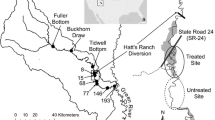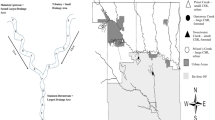Abstract
Channel incision is a widespread phenomenon that results in stream and riparian habitat degradation. Fishes and physical habitat variables were sampled at base flow from three incised stream channels and one reference stream in northwest Mississippi, USA, to quantify incision effects on fish habitat and provide a basis for habitat rehabilitation planning and design. Incised channels were sampled in spring and autumn; the reference channel was sampled only in the autumn. Incised channel habitat quality was inferior to the reference channel despite the presence of structures designed to restore channel stability. Incised channels had physical habitat diversity levels similar to a nonincised reference channel, but contained fewer types of habitat. At base flow, incised channels were dominated by shallow, sandy habitats, moderate to high mean local Froude numbers, and had relatively little organic debris in their beds. In contrast, the reference stream had greater mean water depth, contained more woody debris, and provided more deep pool habitat. Fish assemblages in incised channels were composed of smaller fishes representing fewer species relative to the reference site. Fish species richness was directly proportional to the mean local Froude number, an indicator of the availability of pool habitat.
Similar content being viewed by others
Literature Cited
Campbell, K. L., S. Kumar, and H. P. Johnson. 1972. Stream straightening effects on flood-runoff characteristics.Transactions of the American Society of Agricultural Engineers 15(1):94–98.
Capone, T. A., and J. A. Kushlan. 1991. Fish community structure in dry-season stream pools.Ecology 72(3):983–992.
Cooper, C. M., and S. S. Knight. 1987. Fisheries in manmade pools below grade-control structures and in naturally occurring scour holes of unstable streams.Journal of Soil and Water Conservation 42(5):370–373.
Cooper, C. M., and S. S. Knight. 1991. Water quality cycles in two hill land streams subjected to natural, municipal, and non-point agricultural stresses in the Yazoo Basin of Mississippi, USA (1985–1987).International Association of Theoretical and Applied Limnology 24:1654–1663.
Foltz, J. W. 1982. Fish species diversity and abundance in relation to stream habitat characteristics. Pages 305–311in Proceedings of the thirty-sixth annual conference of the southeastern association of fish and wildlife agencies.
Galay, V. J. 1983. Causes of river bed degradation.Water Resources Research 19(5):1057–1090.
Gorman, O. T., and J. R. Karr. 1978. Habitat structure and stream fish communities.Ecology 59(3):507–515.
Grissinger, E. H., and J. B. Murphey. 1982. Present “problem” of stream channel instability in the bluff area of northern Mississippi.Journal of the Mississippi Academy of Sciences 27:117–128.
Grissinger, E. H., and J. B. Murphey. 1983. Present channel stability and late Quaternary valley deposits in northern Mississippi.International Association Sediment Special Publication No. 6:241–250.
Grissinger, E. H., and J. B. Murphey. 1986. Bank and bed adjustments in a Yazoo bluffline tributary.In, Wang, S. Y., H. W. Shen, and L. Z. Ding (eds.) Proceedings of the third international symposium on river sedimentation. The University of Mississippi, Oxford, Mississippi, 31 March–4 April.
Happ, S. C., G. Rittenhouse, and G. C. Dobson. 1940. Some principles of accelerated stream and valley sedimentation. Technical bulletin No. 695, United States Department of Agriculture, Washington, DC.
Harvey, M. D., and C. C. Watson. 1986. Fluvial processes and morphological thresholds in incised channel restoration.Water Resources Bulletin, American Water Resources Association 22(3):359–368.
Higler, L. W. G., and A. W. M. Mol. 1984. Ecological types of running water based on stream hydraulics in the Netherlands.Hydrobiological Bulletin 18(1):51–57.
Hortle, K. G., and P. S. Lake. 1982. Macroinvertebrate assemblages in channelized and unchannelized sections of the Bunyip River, Victoria.Australian Journal of Marine and Freshwater Research 33:1071–1082.
Hortle, K. G., and P. S. Lake. 1983. Fish of channelized and unchannelized sections of the Bunyip River, Victoria.Australian Journal of Marine and Freshwater Research 34:441–450.
Horwitz, R. J. 1978. Temporal variability patterns and the distributional patterns of stream fishes.Ecological Monographs 48:307–321.
Hughes, R. M., Larsen, D. P. and Omernik, J. M. 1986. Regional reference sites: A method for assessing stream potentials.Environmental Management 10(5):629–635.
Karr, J. R. 1991. Biological integrity: A long-neglected aspect of water resource management.Ecological Applications 1(1):66–84.
Knight, S. S., and C. M. Cooper. 1987. Fishes of Otoucalofa Creek, Mississippi prior to major channel modifications.Journal of the Mississippi Academy of Sciences 32:31–38.
Knight, S. S., and C. M. Cooper. 1990. Fishes of Hotophia Creek, Mississippi.Journal of the Mississippi Academy of Sciences 35:1–12.
Lobb, M. D., III, and D. J. Orth. 1991. Habitat use by an assemblage of fish in a large warmwater stream.Transactions of the American Fisheries Society 120:65–78.
Magurran, A. E. 1988. Ecological diversity and its measurement. Croom Helm Limited, London.
Mason, R. R., Jr., C. E. Simmons, and S. A. Watkins. 1990. Effects of channel modifications on the hydrology of Chicod Creek Basin, North Carolina, 1975–87. US Geological Survey Water-Resources Investigations Report 90-4031. U.S. Department of Agriculture, Soil Conservation Service, Raleigh, North Carolina.
Meffe, G. K., and Sheldon, A. L. 1988. The influence of habitat structure on fish assemblage composition in southeastern blackwater streams.The American Midland Naturalist 120(2):225–2240.
Menge, B. A. 1976. Organization of the New England rocky intertidal community: Role of predation, competition, and environmental heterogeneity.Ecological Monographs 46:355–393.
Neill, C. R., and J. P. Johnson. 1989. Long Creek watershed field investigation and geomorphic analyses. Northwest Hydraulic Consultants, Inc., Kent, Washington.
Peckarsky, B. L., S. C. Horn, and B. Statzner. 1990. Stonefly predation along a hydraulic gradient: A field test of the harsh-benign hypothesis.Freshwater Biology 24:181–191.
Pflieger, W. L. 1975.The fishes of Missouri. Missouri Department of Conservation, Jefferson City, 343 pp.
Piest, R. F., L. S. Elliott, and R. G. Spomer. 1977. Erosion of the Tarkio drainage system, 1845–1976.Transactions of the American Society of Agricultural Engineers 20(3):485–488.
Reice, S. R., R. C. Wissmar, and R. J. Naiman. 1990. Disturbance regimes, resilience, and recovery of animal communities and habitats in lotic ecosystems.Environmental Management 14(5):647–659.
Richards, K. 1982. Rivers: Form and process in alluvial channels. Methuen and Co. Ltd., London, 358 pp.
Robison, H. W., and T. J. Buchanan. 1988.Fishes of Arkansas. University of Arkansas Press, Fayetteville, 536 pp.
Ross, S. T., and W. M. Brenneman. 1991. Distribution of freshwater fishes in Mississippi. Completion report, Dingell-Johnson project F-69, Mississippi Department of Wildlife, fisheries, and Parks, Bureau of Fisheries and Wildlife, Jackson, 548 pp.
Ross, S. T., W. J. Matthews, and A. A. Echelle. 1985. Persistence of stream fish assemblages: Effects of environmental change.The American Naturalist 126(1):24–40.
Scarnecchia, D. L. 1988. The importance of streamlining in influencing fish community structure in channelized and unchannelized reaches of a prairie system.Regulated Rivers: Research and Management 2:155–166.
Schlosser, I. J. 1982. Fish community structure and function along two habitat gradients in a headwater stream.Ecological Monographs 52(4):395–414.
Schlosser, I. J. 1985. Flow regime, juvenile abundance, and the assemblage structure of stream fishes.Ecology 66(5):1484–1490.
Schlosser, I. J. 1987. A conceptual framework for fish communities in small warmwater streams.In W. J. Matthews and D. C. Heins (eds.), Community and evolutionary ecology of north American stream fishes. University of Oklahoma, Norman, Oklahoma.
Shankman, D., and S. A. Samson. 1991. Channelization effects on Obion River flooding, western Tennessee.Water Resources Bulletin, American Water Resources Association 27(2):247–254.
Shields, F. D., Jr. and J. J. Hoover. 1991. Effects of channel restabilization on habitat diversity, Twentymile Creek, Mississippi.Regulated Rivers: Research and Management 6:163–181.
Shields, F. S., Jr., and R. H. Smith. 1992. Effects of large woody debris removal on physical characteristics of a sand-bed river.Aquatic Conservation: Marine and Freshwater Ecosystems 2:145–163.
Shields, F. D., Jr., C. M. Cooper, and S. S. Knight. 1992. Rehabilitation of aquatic habitats in unstable Streams.In Proceedings of the fifth international symposium on river sedimentation. University of Karlsruhe, Germany.
Simon, A. 1989. The discharge of sediment in channelized alluvial streams.Water Resources Bulletin, American Water Resources Association 25(6):1177–1188.
Simon, A., and C. R. Hupp. 1986. Channel evolution in modified Tennessee channels. Proceedings of the 1986 federal interagency sedimentation conference, 5-71–5-82.
Simon, A., and C. H. Robbins. 1987. Man-induced gradient adjustment of the South Fork Forked Deer River, west Tennessee.Environmental Geology and Water Science 9(2):109–118.
Simons, D. B., and F. Senturk. 1977. Sediment transport technology. Water Resources Publications, Fort Collins, Colorado, 807 pp.
Slack, L. J. 1992. Water-quality and bottom-material-chemistry data for the Yazoo River Basin Demonstration Erosion Control Project, North-Central Mississippi, February 1988–September 1991. US Geological Survey Open-File Report 92-469, Jackson, Mississippi.
Statzner, B., J. A. Gore, and V. H. Resh. 1988. Hydraulic stream ecology: Observed patterns and potential applications.North American Benthological Society 7(4):307–360.
Sullivan, K. 1986. Hydraulics and fish habitat in relation to channel morphology. PhD dissertation submitted to The Johns Hopkins University, Baltimore, Maryland. University Microfilms International, Ann Arbor, Michigan.
Swales, S. 1988. Fish populations of a small lowland channelized river in England subject to long-term river maintenance and management works.Regulated Rivers: Research and Management 2:493–506.
Tramer, E. J., and P. M. Rogers. 1973. Diversity and longitudinal zonation in fish populations of two streams entering a metropolitan area.The American Midland Naturalist 90(2):366–374.
Whitten, C. B., and D. M. Patrick. 1981. Engineering geology and geomorphology of streambank erosion. Technical report GL-79-7, report 2 (of a series): Yazoo River Basin Uplands, Mississippi.
Wilcock, D. N., and C. I. Essery. 1991. Environmental impacts of channelization on the river main, County Antrim, Northern Ireland.Journal of Environmental Management 32:127–143.
Yount, J. D., and G. J. Niemi. 1990. Recovery of lotic communities and ecosystems from disturbance—a narrative review of case studies.Journal of Environmental Management 14(5):547–569.
Zimmer, D. W., and R. W. Bachmann. 1976. A study of the effects of stream channelization and bank stabilization on warmwater sport fish in Iowa. Subproject No. 4. The effects of long-reach channelization on habitat and invertebrate drift in some Iowa streams. Iowa Cooperative Fishery Research Unit, Ames, Iowa.
Author information
Authors and Affiliations
Rights and permissions
About this article
Cite this article
Shields, F.D., Knight, S.S. & Cooper, C.M. Effects of channel incision on base flow stream habitats and fishes. Environmental Management 18, 43–57 (1994). https://doi.org/10.1007/BF02393749
Issue Date:
DOI: https://doi.org/10.1007/BF02393749




